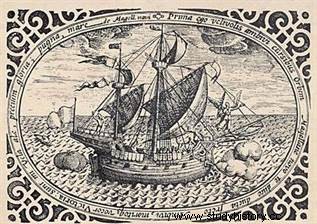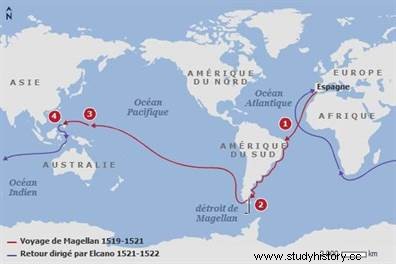 Fernand de Magellan (circa 1480-1521) was a Portuguese explorer of the 16th century. He was the first to have found, south of the New World (America), a passage from the Atlantic Ocean to the Pacific Ocean, still unknown to Europeans. Arrived in the archipelago of the Philippines, he was killed there during a confrontation with the inhabitants. His expedition, under the command of one of his men, Juan Sebastián Elcano, however managed to return to Spain in 1522. The first circumnavigation of the globe by sea had just been completed, it took three years. After a little over a quarter of a century, the dream of Christopher Columbus had come true and, as historian Pierre Chaunu said, "never was the world as big as it was after Magellan's journey" .
Fernand de Magellan (circa 1480-1521) was a Portuguese explorer of the 16th century. He was the first to have found, south of the New World (America), a passage from the Atlantic Ocean to the Pacific Ocean, still unknown to Europeans. Arrived in the archipelago of the Philippines, he was killed there during a confrontation with the inhabitants. His expedition, under the command of one of his men, Juan Sebastián Elcano, however managed to return to Spain in 1522. The first circumnavigation of the globe by sea had just been completed, it took three years. After a little over a quarter of a century, the dream of Christopher Columbus had come true and, as historian Pierre Chaunu said, "never was the world as big as it was after Magellan's journey" .
Fernand de Magellan, intrepid navigator
During the 15th century, European navigators set out to find new routes to the East. the Portuguese, who knew how to build vassals capable of carrying out long journeys at sea, did the work of pioneers. Bartolomé Diaz was thus the first to reach the southern tip of Africa. In the process, the navigators Vasco de Gama and Cabral rounded the Cape of Good Hope to reach India (1498-1500) and established counters there in Goa and Callicut. Magellan would take on an even greater challenge, reaching the East Indies via the southwest and the Pacific Ocean.
 The origins of Fernão de Magalhães, in French Fernand de Magellan, are obscure. Coming from a family with multiple ramifications in the north of the Portuguese, it is assumed that he was born around 1480. On the other hand, it is certain that he embarked in 1506 for the East Indies, participating in several expeditions on the coast East Africa and India. In 1511, he took part in the capture of Malacca. Magellan will not go any further, but his friend Francisco Serrão will travel to the Moluccas in 1512, from where he will send letters to Magellan describing these distant islands where cloves grow.
The origins of Fernão de Magalhães, in French Fernand de Magellan, are obscure. Coming from a family with multiple ramifications in the north of the Portuguese, it is assumed that he was born around 1480. On the other hand, it is certain that he embarked in 1506 for the East Indies, participating in several expeditions on the coast East Africa and India. In 1511, he took part in the capture of Malacca. Magellan will not go any further, but his friend Francisco Serrão will travel to the Moluccas in 1512, from where he will send letters to Magellan describing these distant islands where cloves grow.
In the service of Charles V
He returned in early 1513, and fought at Azemmour in Morocco, where he received a wound to the back of his knee. Back in Portugal, dissatisfied with his situation, he left for Spain in 1517 to propose to the Spaniards a grandiose project:to find a passage to the south of South America to reach the Spice Islands which he supposed to be located in half of the sphere reserved for the Spaniards since the Treaty of Tordesillas (1494).
Recall that the meridian fixed at Tordesillas roughly passed through the mouths of the Amazon. Everything to the east of this line was reserved for Portuguese explorations, everything to the west was for the Spaniards. On the other side of the world, an anti-meridian extended the Meridian, dividing the globe into two hemi-spheres of influence. You should also know that all the world production of cloves and nutmeg then came from the two small archipelagos of the Moluccas and Banda.
 He then offered his services to King Charles I of Spain, the future Charles V. For two years, exposed to Spanish suspicions and Portuguese maneuvers, he methodically prepared his expedition. On September 20, 1519, Fernand de Magellan weighed anchor in Sanlúcar de Barrameda, the port of Seville, with five ships and 437 men on board (440 after a stopover in the Canary Islands):the Trinidad, the Victoria, the Concepcion, the San Antonio and the Santiago. Magellan himself took his place aboard the Trinidad.
He then offered his services to King Charles I of Spain, the future Charles V. For two years, exposed to Spanish suspicions and Portuguese maneuvers, he methodically prepared his expedition. On September 20, 1519, Fernand de Magellan weighed anchor in Sanlúcar de Barrameda, the port of Seville, with five ships and 437 men on board (440 after a stopover in the Canary Islands):the Trinidad, the Victoria, the Concepcion, the San Antonio and the Santiago. Magellan himself took his place aboard the Trinidad.
Magellan explores the Pacific
In mid-December he landed in the bay of Rio de Janeiro. In February 1520 he explored the estuary of the Río de la Plata and on March 31, 1520 his fleet landed in the harbor of San Julián, where it remained for nearly six months. During this period a mutiny broke out and the sinking of a ship was deplored. After stifling the revolt, Magellan discovered on November 21 the entrance to the strait that would bear his name. The crossing was made without incident, except for the desertion of a ship carrying 57 men.
On December 28, three ships undertook the first crossing of the great ocean that Magellan calls "Pacific". He reached the Marianas, or "thieves' islands" on March 6, 1521 and ten days later discovered the Philippines. He docked at Cebu Island on April 7. There he made an alliance with the ruler of the island and offered to fight the natives of the neighboring island of Mactan. Magellan was killed with a poison arrow on April 27, 1521 during the battle. An ambush fomented by the King of Cebu awaited his companions on their return:the sailors counted 26 dead in their ranks. The survivors hurriedly fled.
A world tour completed... without Magellan
After Magellan's death, the third ship was burned, for lack of men to maneuver it, but the other two reached the Moluccas on November 6, 1521. La Trindade then attempted a return by the Pacific. It was a failure, the ship ended up boarded and its men taken prisoner by the Portuguese. La Victoria, commanded by a former mutineer, the Basque Juan Sebastián Elcano, completed the journey passing by the Cape of Good Hope and arrived in Sanlúcar de Barrameda on September 6, 1522, almost three years after its departure. Eighteen Europeans disembarked; twelve others, detained for a time in Cape Verde, joined them a few weeks later.
 If the first trip around the world caught the imagination, it turned out to be a failure. The load of spices brought back to Spain on the Victoria only partially reimbursed the shipping costs. The passage through the Strait of Magellan will be too long and too difficult to constitute a regular route between Europe and Asia, and Spain had to give up the Moluccas. Nevertheless, the voyage laid the groundwork for trade between the New World and the Orient. But it was not until 1565 that López de Legazpi succeeded in creating a maritime link between the Philippines, which the Spaniards and Mexico would appropriate.
If the first trip around the world caught the imagination, it turned out to be a failure. The load of spices brought back to Spain on the Victoria only partially reimbursed the shipping costs. The passage through the Strait of Magellan will be too long and too difficult to constitute a regular route between Europe and Asia, and Spain had to give up the Moluccas. Nevertheless, the voyage laid the groundwork for trade between the New World and the Orient. But it was not until 1565 that López de Legazpi succeeded in creating a maritime link between the Philippines, which the Spaniards and Mexico would appropriate.
Bibliography
- Magellan's Voyage (1519-1521). Pigafetta's relationship &other testimonies. Edition established by Xavier de Castro, in collaboration with Jocelyne Hamon and Luís Filipe Thomaz. Preface by Carmen Bernand and Xavier de Castro. Chandeigne, 1048 p. 2007; 2nd ed., 2010. This edition is the first in the world to have collected and confronted all the direct testimonies, with many novelties and corrections. Xavier de Castro, pseudonym of Michel Chandeigne, is a specialist in cartography and discoveries, and the author of numerous conferences on these themes.
- Magellan by Stefan Zweig, biography. Grasset, 2003.
- Fernando de Magellan by Antonio Pigafetta, biography. Tallandier, 2005.
- Magellan by Jules Verne, biography. Magellan &Co., 2005.
